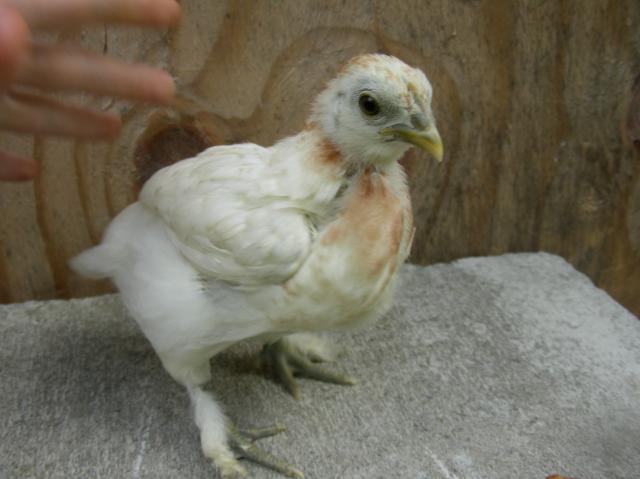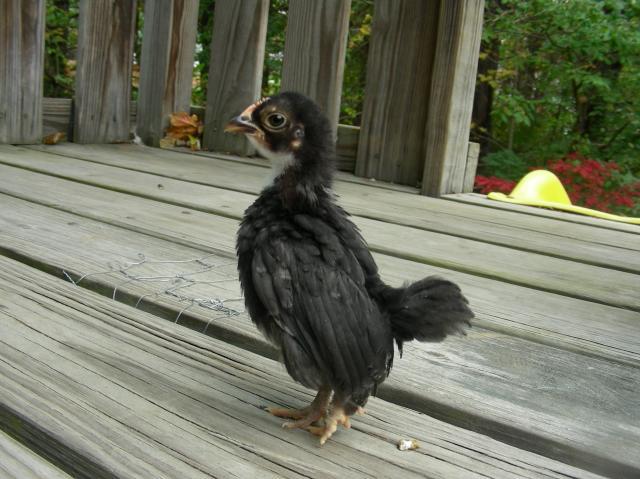1. i recently aquired a silkie pullet i originally thought was white, but upon closer examination i noticed a few gray splashed primary, foot and crest feathers, but only a few. does this make her a defected white silkie or a very lightly splashed silkie?
2. the pullet in the picture below was hatched about 7-8 weeks ago. her mother is by a black mottled d'uccle/ black silkie mother and a black mottled d'uccle/black cochinX BB red oegb sire. her sire could be either a pure wheaten ameraucana or a mix breed bantam by the same sire as the hen and the mother a bantam mix of white cornish, black cochin, black silkie, and black rosecomb. which is the pullet's sire? if it's hard to tell from the pic, i can discribe her: dark fawn head fading down the hackle to white on the back. tail is white tipped with fawn. fluff is white. breast is dark rich fawn fading to white tipped with fawn, then pure white along the keel. white thighs/hocks. foot feathers white tipped with a bar of gray, a bar of fawn then more white. wing shoulders are white and dark fawn barred. primary coverts are white with a bar of gray, a bar of fawn and a white tip, secondary coverts are white tipped with a bar of fawn then more white. primaries are gray with white lacing. secondaries are faint gray that grows darker toward the tip of the feather with white lacing and a bar of fawn at the tip of the gray. as a chick her down was pale yellow with a spot of buff on the back of the head.

3. this 8 week old cockerel is a mix of a class C serama hen and either a lavender dutch or a black mottle d'uccle/black cochinX BB red OEGB. i suspect the 2nd because of the cockerels mottled coloration although the serama may be a black carrier, even though it's unlikely. he is black with some white mottling on he thighs and the tips of his flights. also, why is he so small? he weighs 2 oz at 8 weeks when my class A serama pullet weighed that at four weeks!

thanks in advance!
2. the pullet in the picture below was hatched about 7-8 weeks ago. her mother is by a black mottled d'uccle/ black silkie mother and a black mottled d'uccle/black cochinX BB red oegb sire. her sire could be either a pure wheaten ameraucana or a mix breed bantam by the same sire as the hen and the mother a bantam mix of white cornish, black cochin, black silkie, and black rosecomb. which is the pullet's sire? if it's hard to tell from the pic, i can discribe her: dark fawn head fading down the hackle to white on the back. tail is white tipped with fawn. fluff is white. breast is dark rich fawn fading to white tipped with fawn, then pure white along the keel. white thighs/hocks. foot feathers white tipped with a bar of gray, a bar of fawn then more white. wing shoulders are white and dark fawn barred. primary coverts are white with a bar of gray, a bar of fawn and a white tip, secondary coverts are white tipped with a bar of fawn then more white. primaries are gray with white lacing. secondaries are faint gray that grows darker toward the tip of the feather with white lacing and a bar of fawn at the tip of the gray. as a chick her down was pale yellow with a spot of buff on the back of the head.

3. this 8 week old cockerel is a mix of a class C serama hen and either a lavender dutch or a black mottle d'uccle/black cochinX BB red OEGB. i suspect the 2nd because of the cockerels mottled coloration although the serama may be a black carrier, even though it's unlikely. he is black with some white mottling on he thighs and the tips of his flights. also, why is he so small? he weighs 2 oz at 8 weeks when my class A serama pullet weighed that at four weeks!

thanks in advance!
